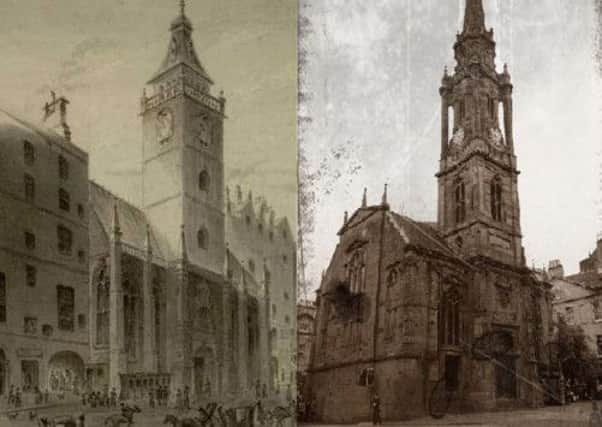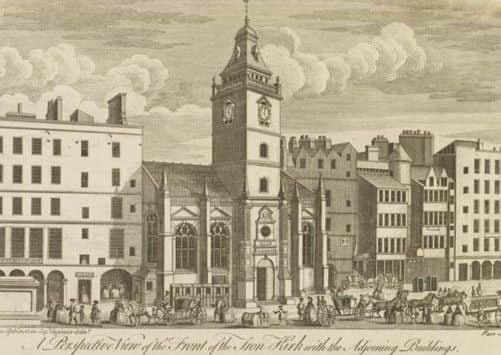Lost Edinburgh: The Tron Kirk


Since its foundations were laid in the 1640s the structure has had to endure massive alterations and face a number of threats to its existence.
The founding of the Tron Kirk was ordered by King Charles I after the bishopric designation of Edinburgh’s High Kirk, St. Giles in the royal charter of 1633. The North-West parish congregation displaced by St. Giles’s changing status required a new home and work began on the Tron Kirk in 1636, following demolition of several multi-floored medieval tenements on Marlin’s Wynd between the High Street and the Cowgate. The design of the building incorporated an effective blend of Gothic and Classical styles.
Advertisement
Hide AdAdvertisement
Hide AdIt was originally a little larger and of a different layout than the kirk that stands today. The church was topped with a distinctive Dutch-style steeple reminiscent of Old St. Ninian’s Church in Leith. The Tron’s name derives from the nearby weigh tron, a merchant weighing beam which existed on this part of Edinburgh’s High Street at this time. It was in the kirk in 1693 that a Mr Areskine is reported as praying “Lord have mercy on a’ fools and idiots and particularly on the Magistrates of Edinburgh”.


The kirk remained largely unchanged until the 1780s when the works to create South Bridge, Hunter Square and Blair Street called for the shortening of the building’s east and south aisles. The western edge of the kirk removed in order to restore symmetry. The creation of the new streets also saw the kirk open on all sides for the first time due to the removal of the tenements which had previously hemmed it in place on the High Street.
The next pivotal event for the church would render it almost unrecognisable. The Great Fire of Edinburgh on the 16th of November 1824 ravaged Scotland’s capital. Ten lives were lost and hundreds of families made homeless due to the inferno. Over £200,000 worth of damage was inflicted on the south side of Edinburgh’s High Street which included the toppling of the Tron Kirk’s famous Dutch-influenced steeple.
The mixture of lead and wood in the tower’s framework acted as the perfect kindling, ultimately forcing its complete removal in the aftermath of the fire. Fortunately, the interior of the kirk, including its fine hammer beam roof, managed to escape the flames. The current Tron Kirk steeple, which was a totally new design, was created in 1828. The new significantly taller spire was constructed entirely from stone – presumably to prevent it from falling victim to fire ever again.
Advertisement
Hide AdAdvertisement
Hide AdIn the years that followed, the Tron Kirk became the traditional gathering place for Edinburgh citizens during the city’s Hogmanay celebrations, a role that lasted until 1993 when Princes Street took over New Year’s Eve duties as reveller numbers exploded.
Since the congregation departed in 1952 for a new church in Moredun, the threat of extinction has loomed heavy on the Tron Kirk. Plans to remove the church in its entirety were raised more than once during the 20th century in a bid to improve traffic flow around the busy junction of the Bridges and the Royal Mile. Thankfully those plans never came to fruition and instead a restoration programme commenced in 1974. However, the restoration work on the floor and foundations of the church uncovered something unexpected. Remnants of 16th century shops and dwellings on historic Marlin’s Close were visible and the site quickly became of considerable archaeological interest.
In recent years the category A listed Tron Kirk appears to have staved off the threat of destruction. It enjoyed a spell as a tourist information centre during the 2000s and has embarked on a new lease of life as an entertainment complex and Fringe venue in the last year. The excavated remains of the medieval Marlin’s Close have been glassed over creating a unique and fascinating window into Edinburgh’s deep past as you walk around the interior. the latest information suggests that the church will be reopened long-term in the near future.
Pieces of the Tron Kirk may have disappeared over the centuries, but so far its complete loss has been satisfyingly avoided. The future looks promising for what is one of the most historic and culturally important architectural landmarks in Scotland’s capital city.